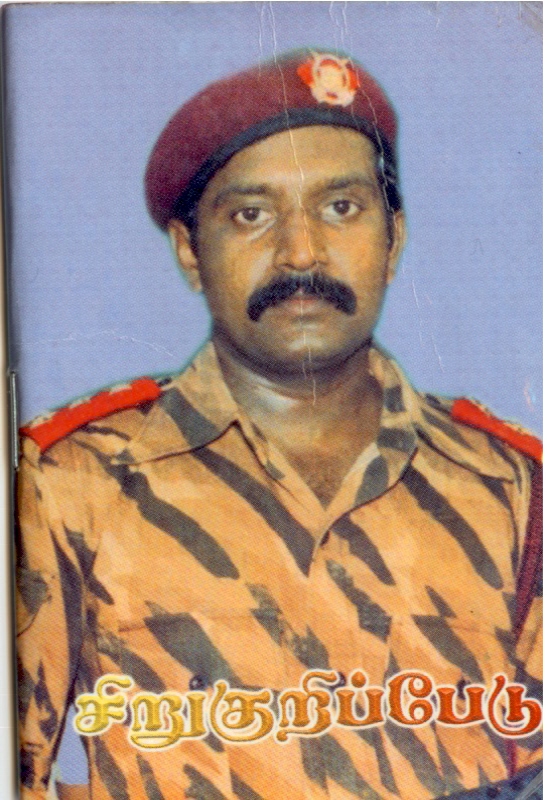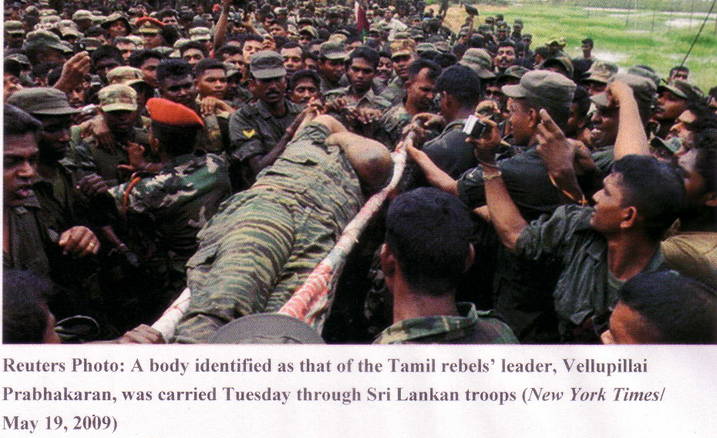If there was ever a competition to find the person who summed up the adage which says that 'one man's terrorist is another man's freedom fighter', then Velupillai Prabhakaran, the rotund but fearsome leader of the Tamil Tigers, would have been a strong candidate. For nearly 30 years, the moustachioed commander's brutal war to create an independent 'Eelam' (homeland) for Sri Lanka's minority Tamils teetered on the often thin line between a struggle for liberation and outright terrorism.
To his detractors, the founder of the Liberation Tigers of Tamil Eelam (LTTE) was little more than a ruthless terrorist who pioneered the use of suicide bombings to assassinate two heads of state, viciously annihilated his own Tamil critics and stubbornly refused any compromise that might have led to peace. Yet to the thousands of fighters who followed him to their deaths, and to the millions of Tamils scattered around the world who donated handsomely to the LTTE's coffers, the reticent 54-year-old was a hero and demigod.
Cover story: Sri Lanka. Selvarajah Padmanathan. Liberation Tigers of Tamil Eelam (LTTE)—with the hardware to wage a war that has. Led by its 41-year-old supremo, Velupillai Prabhakaran the Tigers have become far more than a jungle. Velupillai Prabhakaran The LTTE in brief Inception -Liberation Tigers of. Tamil Eelam (LTTE), commonly known. Velupillai Prabakaran History In Tamil Pdf:. Thiruvenkadam Velupillai Prabhakaran (November 26, 1954 – May 19, 2009) was the founder and leader of the Liberation Tigers of Tamil Eelam (the LTTE or the Tamil Tigers), a militant organization that sought to create an independent Tamil state in the north and east of Sri Lanka.
Lovingly referred to by his Tamil nickname, 'Thamby' (little brother), Prabhakaran was viewed by his people as the only man capable of defending Tamil Eelam against Sri Lanka's modern, foreign-funded army and the numerous human-rights violations perpetrated by the country's Buddhist, Sinhalese-dominated central government. His skills as a brilliant military strategist were beyond doubt. By creating an immensely powerful personality cult and a suicide ethos among his fanatically loyal fighters, the LTTE was able to keep a conventional army at bay for decades using little more than assault rifles. But Prabhakaran's willingness to resort to assassinations, random attacks on civilians, the recruitment of child soldiers and the eradication of any democratic Tamil opposition left his Tigers with a bitterly controversial legacy that will haunt Tamil nationalism for many years to come.
We’ll tell you what’s true. You can form your own view.
From 15p€0.18$0.18USD 0.27 a day, more exclusives, analysis and extras.
For the briefest of moments it could have been so very different. The last time that The Independent met the elusive leader was seven years ago, in an iron shed in the now ravaged town of Kilinochchi. Prabhakaran rarely gave interviews and the few journalists who did manage to meet him usually had to go through days of Tiger checkpoints, searches and intense security measures – not to mention the fear of falling victim to a Sri Lankan air strike or artillery shell. But in April 2002 a potential peace was in the air. Sri Lankans had just voted in their new president, Ranil Wickremasinghe, a relative dove who had campaigned on a platform offering talks to the LTTE. Feeling the pressure to distance himself and the Tigers from terrorism post-11 September, Prabhakaran agreed and briefly came out of the jungle to announce that the Tigers were now 'committed to peace'.
When he addressed the gathered journalists, the signature tiger-stripe camouflage uniform and sidearm that he had always worn had been replaced with a more palatable high-buttoned bush jacket. The cyanide capsule worn around his neck as a last resort also remained hidden. But the high-pitched voice was the same, a soft demeanour which belied Prabhakaran's unwillingness to give up the gun. In fact, most people who met him were surprised that such a quietly spoken man could be the feared and brutal leader he was known to be. Eventually the peace talks stalled, Wickremasinghe lost the next presidential election to the hardliner Mahinda Rajapaksa and Prabhakaran's fate was slowly sealed.
He was the middle-class son of a pious government-employed agronomist; Prabhakaran's descent into violence was swift and brutal. Born on 26 November 1954 in the northern coastal town of Valvettithurai, Prabhakaran almost single-handedly ignited the Tamil insurgency when he was 21 by assassinating the governor of Jaffna. His ragtag gang of young nationalists calmly walked up to the governor outside a Hindu temple and gunned him down.
Decades of Sinhalese domination and anti-Tamil policies had created a wealth of seething anger among Sri Lanka's Tamils; Prabhakaran's bullet was the spark that finally set the island alight. Fleeing into the jungle, he set up the LTTE, which quickly became the most effective, efficient and ruthless Tamil rebel group fighting the government.
Long before Islamic jihadists realised the effectiveness of suicide bombs, LTTE cadres from the group's fanatical Black Tiger regiment, many of whom were women, carried out a series of spectacular assassinations, including the murder of India's prime minister Rajiv Gandhi in 1991 and the Sri Lankan president Ranasinghe Premadasa two years later. The attacks were a terrifying but strategically brilliant weapon which could rarely be stopped and struck fear into the hearts of ordinary Sri Lankans.
To explain the Tiger's internecine massacres, the English-speaking Tamil Tiger ideologue Anton Balasingham once remarked: 'Down the history of liberation struggles all over the world, the big fish swallows the smaller fish. In the end, only the big fish remains.' Prabhakaran was determined to make sure that he was the only big fish around.
How Prabhakaran Was Killed
Initially enforcing a vow of chastity on his fanatical fighters, Prabhakaran went on to marry Mathivathani Erambu, a fiery and beautiful student who had vowed to fast to death in support of Tamil Eelam in 1983. Prabhakaran was living in south India at the time and was so determined to control every aspect of the Tamil rebellion that he had the students kidnapped and taken to his compound in Chennai. During the Hindu festival of Holi, Mathivathani had the audacity to throw a bucket of coloured water at the Tamil Tiger leader, who, impressed by her bravery, fell deeply in love. The chastity vow broken, the couple married and went on to have three children, a daughter named Duwaraka, and two sons, Balachandran and Charles Anthony. The latter is thought to be his father's successor. Tamil Tiger cadres are now allowed to marry, but only after five years of military service.
Velupillai Prabhakaran History In Tamil
In many ways, the assassination of Gandhi, in retaliation for the stationing of Indian troops in Sri Lanka, was Prabhakaran's biggest single tactical error. It turned India's generally moderate Tamil population against him, alienated sympathetic allies in Gandhi's Congress Party and reinforced the belief abroad that the LTTE was a violent, terrorist entity that the international community simply could not do business with.
More recently, his second largest mistake was to forbid Tamils from voting in the 2005 presidential election, a decision which allowed his arch-enemy Rajapaksa to take the reigns of power and begin the assault that eventually led to Prabhakaran's death and the military destruction of his organisation. The ruthlessness with which the Tigers eradicated any Tamil opposition also left the Eelam movement lacking any sort of political wing that might have constituted a more palatable public face. And Prabhakaran also made enemies within his own movement.

Prabhakaran Daughter Dead Body
In March 2004, Colonel Karuna, an LTTE commander of 20 years and a close friend of Prabhakaran, publicly broke away from the Tigers and eventually handed over a vast swathe of eastern Sri Lanka to Colombo. Karuna, a feared warlord turned 'integration minister', whom human rights groups have accused of multiple abuses since defecting, brought crucial intelligence with him on the LTTE that helped Rajapaksa prepare for his final assault.

M.R. Narayan Swamy, an Indian journalist who has written the only in-depth biography of Prabhakaran, maintains that opinions of the Tamil Tiger leader among Tamils will always remain mixed. 'There will be no single legacy for Prabhakaran among Tamils,' he said. 'For many he will always be that god-like figure who was a great fighter and a hero. But after 26 years of brutal war there will be some who will start asking whether it was really worth it.'
But without their leader, Swamy believes, the Tigers will never be the same again. 'The LTTE only ever had one leader and only one god. When that god dies, the Tigers will cease to exist. After nearly 30 years of war there is no appetite to begin another armed struggle and the LTTE will never be the same again.'
Jerome Taylor
Velupillai Prabhakaran, founder and leader of the Liberation Tigers of Tamil Eelam: born Valvettithurai, Sri Lanka 26 November 1954; married 1984 Mathivathani Erambu (two sons, one daughter); died Sri Lanka 18 May 2009.
⇒ ⇒ Boomerang Kisah